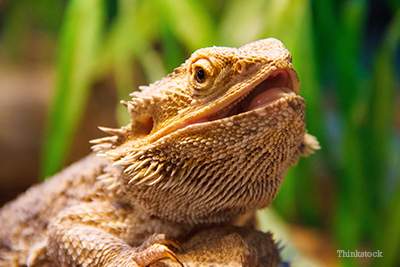Dr. Laurie Hess goes in depth on some of the most common reptile pets. For more from Dr. Hess, find her on Facebook!
Some people love them. Others fear them. Regardless, most of us would agree that they are at least very interesting to look at.
Reptiles: they can make fascinating pets if you are a reptile fan. Whether they hop, climb, or crawl, have legs or not, there’s a reptile for everyone who is intrigued by these animals. With so many reptiles from which to choose, if you’re considering a reptile as a pet, where should you start? Here is part one of my blog on reptiles. Below are 3 different reptiles commonly kept as terrific pets. Next week, I'll add to the list.  1. Bearded dragon lizard
1. Bearded dragon lizard
These medium-sized (1-2 feet long), yellow/brown/orange to red-colored lizards get their name from their ability to puff up the skin over their throats when they are angry or stressed. They are housed in glass tanks heated with over-the-tank lights so that the temperature in the basking zone should be 90-105°F and in the cool zone in the mid-70s°F. They need a tree branch or log for climbing and full-spectrum lighting with a UV-B/UV-A bulb to help them synthesize vitamin D-3 in their skin so that they can properly absorb calcium from their food. They should be fed crickets, mealworms, pinkie or fuzzy mice (dusted with supplemental calcium powder at least twice a week), plus a variety of chopped vegetables such as collards, kale, mustard greens, yellow squash, zucchini and shredded carrots. They should be sprayed daily with water which they will absorb through their skin and lap up off of their noses. If handled often, captive bearded dragons can be tamed to be quite docile and can live, on average, about 7-10 years.
2. Leopard Gecko lizard
These large geckos (8-9 inches long) get their name from their yellow skin covered with brown stripes initially that fade to spots as they age. They live in heated glass aquariums with rocks on which to climb. Temperatures should range from 90°F in the basking zone to the low 70s°F in the cooler area of the tank. Although they are nocturnal, captive leopard geckos living indoors that are never exposed to direct sunlight fare better when exposed to some UV-A/UV-B rays from an ultraviolet bulb. They should be fed crickets regularly, along with occasional mealworms and wax worms (plus a pinkie mouse, if they are large enough to eat it). To provide better nutrition for the gecko, insects they are offered should be fed a diet containing vitamins (“gut-loaded”) and dusted with calcium powder before being fed to the gecko. Leopard geckos need a shallow water dish in which to soak and should be provided with a hide box containing moss or vermiculite that can be misted to provide a high enough humidity to allow normal shedding of skin. These gentle lizards live 8-10 years, on average, in captivity and make great pets for families.
3. Ball python snake
These snakes get their name because they curl themselves up into tight balls when they are nervous, with their heads pulled into the center. They are curious, gentle snakes
that generally grow to 4-5 feet long. In the wild, they eat amphibians, other snakes, birds, and small mammals and do not typically eat the mice that fed to captive pythons. Thus, many ball pythons can be picky eaters that resist eating for weeks to months, at times. They can be housed initially in 10-20 gallon glass tanks with tightly fitting screen lids to prevent escape and with branches on which to climb. Shredded paper products are best used for bedding. They need a log or upside-down cardboard box in which to hide. Tanks must be heated to provide a 90°F basking zone, an 80-85°F cooler zone, and a 70-75°F overall temperature at night. While ball pythons are nocturnal, many captive ball pythons are healthier when exposed daily to full-spectrum light. They must have a shallow bowl of water in which to soak and should be sprayed daily so that tank humidity is 60-70% to shed properly. Ball pythons should be fed only pre-killed rodents (never live, or they may be bitten by their prey). Young snakes may be fed fuzzy mice, and adults may eat full-grown mice or small rats. Ball pythons may be tamed by frequent handling but should not be touched just after eating or in the middle of a shed, as these are times when snakes may be cranky. If maintained properly, ball pythons can make great pets that can live 20-30 years.
If you’re considering a reptile as a pet, whichever one you choose, remember always to wash your hands after handling them, as all reptiles, in general, carry Salmonella bacteria plus other bacteria and parasites that may be transmittable to people. Also, supervise all small children when they handle these pets, as the quick movements of young children can startle and scare these animals. Finally, once you get your new reptile family member, be sure to visit a reptile-savvy vet to have him/her checked and to make sure you’re caring for him/her properly. Remember, many reptiles are so long-lived that if you take care of them right, they may outlive you!
If you have any questions or concerns, you should always visit or call your veterinarian – they are your best resource to ensure the health and well-being of your pets.
